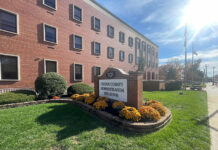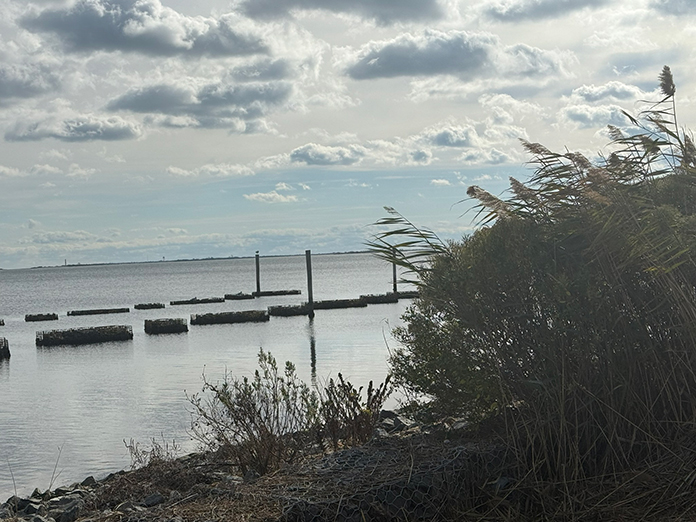
LACEY – Like many local residents, Laura Schetelich loves walking along the path at Bayfront Park in Forked River Beach. She enjoys the calming sound of the waves and the beauty of the native plants. But recently, her peaceful escape was disrupted. Township workers mowed down much of the vegetation along the path, leaving behind a barren landscape. The decision to do so has not only been controversial, but some warn it may contribute to an ongoing erosion problem.
This is the first article in a two-part series about Bayfront Park, examining concerns over aesthetics, waterfront views, and erosion. The series explores how these issues affect residents living along the local government-owned and maintained walkway.
Signs posted throughout the township property advise that the area is not mowed from June to October to protect the terrapins who make their home there. While authorities are not obligated to trim or mow outside these dates, their election to do so appeased some of the ten property owners whose backyards line the path south of the park.
Last fall, homeowners were instructed to notify the township if they wanted authorities to clear the path of foliage along their property lines outside the restricted dates. Only two houses at the southernmost part of the walkway asked that the native plants be kept intact.
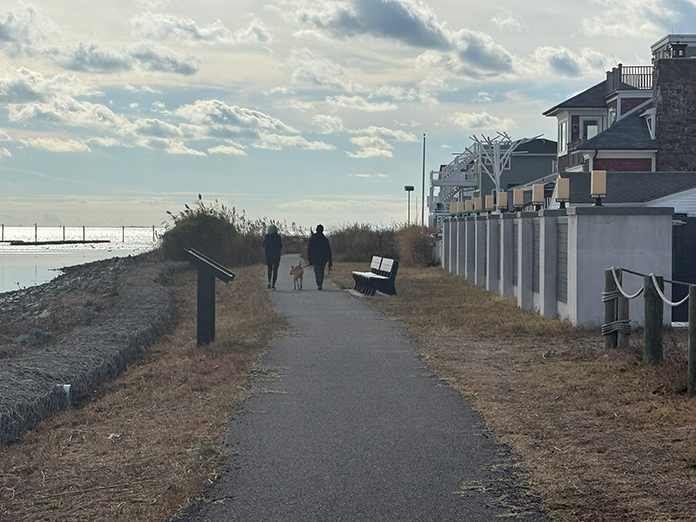
Schetelich isn’t one of the ten homeowners directly affected, but as a Lacey community member, she feels deeply disappointed by the decision regarding public property. At a recent township committee meeting, Schetelich shared concerns she’s expressed on multiple occasions. She described the landscape as a haven for birds and pollinators and lamented that the mowing destroyed what she considered beautiful, beneficial plants.
“In May, when you do that, the milkweed’s not even flowering yet,” she said. “A lot of the flowers aren’t even there, and you’re cutting them down – not even giving them a chance.”
Mayor Peggy Sue Juliano, a Lacey resident since she was ten years old, said she regularly rides her bicycle on the path and considers the native plants a beautiful part of the bay. She also recognizes their value in protecting the shoreline and, if it were solely her decision, would prefer to see what she refers to as the “reeds” remain.
What About The View?
One of the homeowners whose backyard abuts the path, expressed her frustration to the governing body concerning the two homes that requested the township refrain from mowing in front of their properties. Donna Brophy acknowledged the township’s efforts to find a solution but argued against the current state of the path.
“People come here to enjoy the water views,” said Brophy. “They don’t come to go through what I consider to be a jungle in the last two homes where it’s so overgrown you can’t see anything.”
Brophy also raised safety concerns about the overgrowth, sharing an incident where she saw a young boy fall into the weeds and scrape his leg because he couldn’t see where the bottom of the ground was.

“I’m all for milkweed growth,” added Brophy, who said she has some of the side of her house. “I’m all for that but this is not an area that is a nature preserve…if you are concerned about that, plant milkweed around your house like I’ve done to nurture the butterflies.”
Edwin Jarrett, who lives next to the two homes that requested no mowing, echoed Brophy’s sentiments. He appreciated the compromise offered last year, where residents could choose whether to have the area mowed. However, he dismissed claims that the area resembled a sanctuary for birds, describing it instead as unattractive overgrowth.
“When we bought our house, we had a clear view of the Barnegat Lighthouse,” Jarrett said. “I’m from Maine, and I wanted to be near a lighthouse. I loved looking at the Barnegat Lighthouse right from my bedroom window. And now I can’t see the Barnegat Lighthouse; I’ve got bushes now that are probably 10-12 feet tall because two people have held out and said that they don’t want it mowed.”
Other residents expressed concerns about the plants attracting mosquitoes. However, a letter dated October 25, 2023, from Michael Senyk, Superintendent of the Ocean County Mosquito Extermination Commission, provided clarity.
Senyk explained that the commission regularly inspects and treats mosquito breeding areas near Forked River Beach Bayfront Park, including infiltration basins and a salt marsh impoundment. While the commission encourages mowing residential turfgrass to deter mosquitoes, it discourages cutting salt marsh grasses, emphasizing their role in preventing erosion and supporting a healthy ecosystem.
“Salt marsh grasses are crucial in preventing marsh erosion because the root masses help to hold the substrate from breaking apart during tidal flooding,” Senyk wrote. “Protecting salt marsh grasses is so important that the Mosquito Commission is required and regulated to impose minimal impact on salt marsh vegetation while conducting mosquito control activities.”
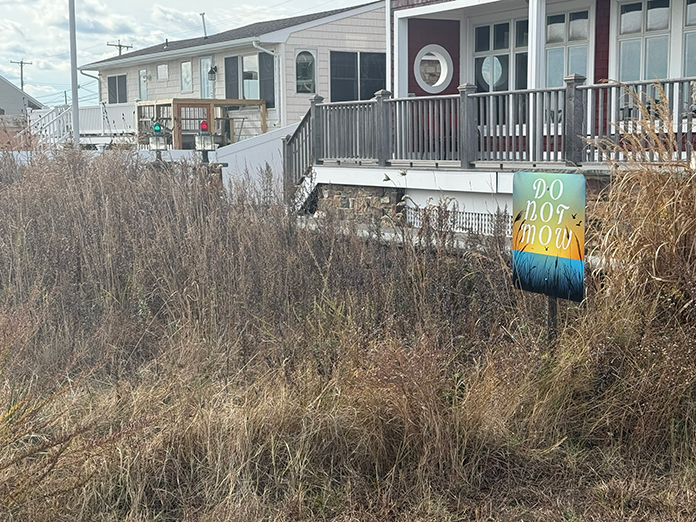
Deputy Mayor Peter Curatolo said he wasn’t in favor of letting the plants grow to the point where it looked like a “jungle.” He suggested the township should mow by the entire path during the times permitted. He added that as an employee of the Ocean County Health Department, he had concerns about the dangers of mosquitos carrying the West Nile virus and argued that reducing their habitat would force them elsewhere.
Complaints that native plants along the pathway are impeding access offered another point of contention. Two individuals walking their dog side by side appeared to navigate the path with ease. Space for someone approaching from the opposite direction to pass was much like that of people walking on a standard sidewalk. Expanded accessibility might be achieved by pruning the foliage rather than cutting it down entirely.
Native Plants And Erosion
Schetelich, who observed township workers “hacking down” the native plants in October, was disheartened to see vibrant flowers still in bloom being destroyed. “They can be pruned back, if necessary,” she said. “But cutting them down to the ground can be very detrimental because if the water comes up that high and covers their roots, they won’t get the oxygen they need to live. And they are part of the erosion control down there.”
None of the people concerned about the aesthetics and their views of the bay addressed the role of the native plants in combatting erosion issues during the meeting. However, Kelly Stankowski, who frequently uses the path and is a homeowner in a private beach club yards away, expressed concerns.
“These plants are essential to holding the soil and protecting our community from storm damage, especially during the storm season,” Stankowski said. “I urge the council to reconsider this action and make it the last time we compromise the natural defenses of Bayfront Park.”
Pat Doyle is one of the two homeowners who requested no mowing along their property. Her family first bought their home in 1966, with Doyle establishing full-time residency in 2006. A dedicated gardener, Doyle values the native plants. However, she also emphasized their role in preventing erosion in an area that once boasted a sandy swimming beach.
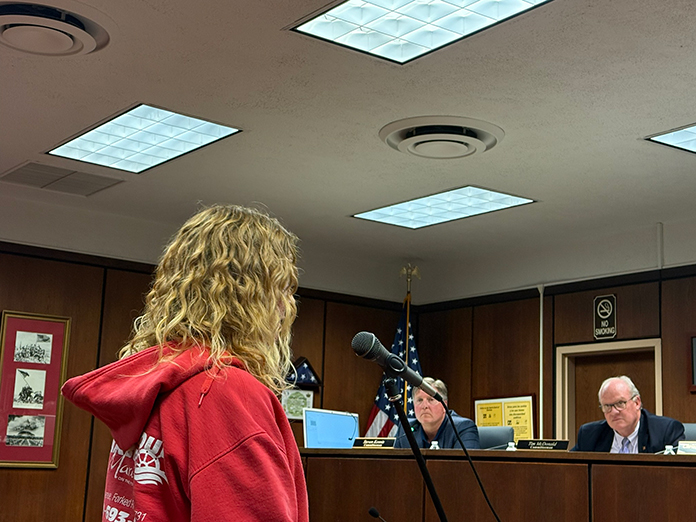
“Our primary concern with the vegetation on the shoreline is to assist in mitigating our encroaching erosion issue,” said Doyle. “The township has already taken some steps; however, we know more is needed. The vegetation is a first line of defense until more can be accomplished.”
“We are very grateful,” Doyle continued. “We know this is township property and respect it.”
Bayfront Park itself has a long history, originally established as the Forked River Beach Club in 1954. Lacey Township purchased the property in 1990 for $2.6 million. Erosion has been a pressing issue for the municipality, with residents urging local officials to address it as early as September 1990.
Look for part two in our series to learn more about steps taken to address Bayfront Park’s erosion problem and information provided by environmental experts.





